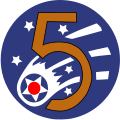This article includes a list of general references, but it lacks sufficient corresponding inline citations .(December 2012) |
388th Electronic Warfare Squadron  | |
|---|---|
 EF-111A Raven 68-0023 at Mountain Home AFB | |
| Active | 1942–1946; 1947–1949; 1954–1959, 1977–1979, 1981–1982, 2004–2010, 2024-present |
| Country | |
| Branch | |
| Role | Electronic Warfare |
| Part of | Air Combat Command |
| Engagements | Antisubmarine Campaign Southwest Pacific Theater [1] |
| Decorations | Distinguished Unit Citation Air Force Outstanding Unit Award Philippine Presidential Unit Citation [1] |
| Insignia | |
| 388th Electronic Combat Squadron emblem [a] [1] |  |
| 388th Fighter-Bomber Squadron emblem [b] [1] |  |
| 388th Bombardment Squadron emblem [2] |  |


The 388th Electronic Warfare Squadron is an active United States Air Force unit, stationed at Eglin Air Force Base, where it is assigned to the 350th Spectrum Warfare Wing.

